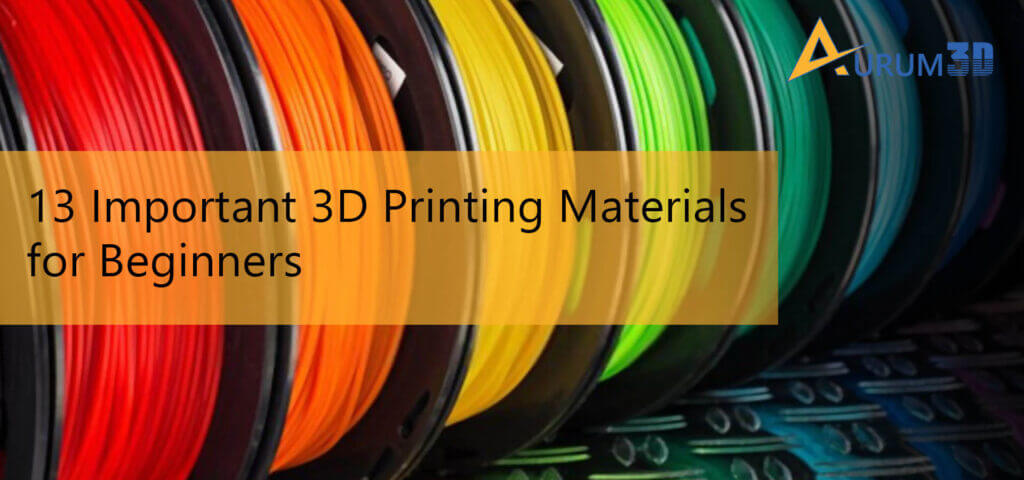Both individuals and enterprises have the option to choose from a wide range of 3D printers. The 3D printers can be broadly divided into two categories – single-material 3D printers and multi-material 3D printers. Unlike single-material 3D printers, multi-material 3D printers contain multiple nozzles. Each of these nozzles deposits a single and specific material into the build area. Each advanced model of 3D printer supports new printing materials.
The manufacturers can use 3D printers to produce a variety of three-dimensional objectives and patterns physically. Hence, they need to choose the 3D printing material according to the nature and requirements of the real-world product. The manufacturers must remember that the 3D printing materials differ from each other in several aspects – features, texture, flexibility, cost, strength and weakness. That is why it becomes essential to understand and compare some of the commonly used 3D printing materials.
Brief Overview of 13 Widely Used 3D Printing Materials
Polyastic Acid (PLA)
The 3D printing material helps manufacturers to print real-world objects using a dynamic raw material like plastic. The 3D printers produce three-dimensional patterns and models by melting and depositing polyastic acid (PLA) layer by layer. PLA is one of the eco-friendly and biodegradable raw materials which are produced from natural products like corn starch and sugarcane. The manufacturers also have the option to use PLA in both hard and soft forms. The easy-to-print 3D printing material further comes in several colors. But PLA is less sturdy than other 3D printing materials. The manufacturers opt for PLA to produce three-dimensional objects which will not be exposed to heat.
Acrylonitrile Butadiene Styrene (ABS)
Acrylonitrile butadiene styrene (ABS) is a form of thermoplastic. Many manufacturers opt for ABS due to its optimal accessibility and low cost. Like PLA, ABS is available in a wide range of colors. But ABS, unlike PLA, is not biodegradable. ABS contains pasta-like filaments which make the 3D printing material more flexible and durable than nylon or polyamide. Also, it has a higher melting point than other materials. The manufacturers need a heated bed to produce three-dimensional objects using ABS. At present, ABS is used widely by craftspeople to 3D print innovative toys, jewelries, stickers and vases. Also, engineers use ABS to produce high quality prototypes.
Polyvinyl Alcohol (PVA)
Polyvinyl alcohol (PVA) is a form of synthetic polymer which is soluble in water. In addition to being soluble in water, PVA is both colorless and odorless. It is used widely by beginners to print three-dimensional objects that will be used temporarily. The manufactures do not opt for PVA while printing objects with higher strength and durability. But many manufacturers use PVA to prototype complex and intricate designs. PVA makes it easier for engineers to add more cavities to the prototypes without increasing 3D printing cost. However, the 3D printers must focus on disposing PVA properly and safely.
Polycarbonate (PC)
Polycarbonate (PC) is one of the high strength 3D printing materials. Its distinct properties make PC suitable for tough environments. But the manufacturers need 3D printers with the capability to handle high temperatures to mold and deposit PC efficiently. PC is more prone to shrinkage and wrapping than other 3D printing materials. Hence, many manufacturers opt for PC only when they 3D print molding trays and plastic fasteners. PC is also one of the low cost 3D printing materials. Many manufacturers opt for PC for the purpose of 3D printing components which are complex and heat resistant.
High-Density Polyethylene (HDPE)
High-density polyethylene (HDPE) is a form of thermoplastic polymer which is produced from petroleum. Many manufacturers opt for HDPE due to its easy-to-recycle nature. HDPE is also one of the strong and dense 3D printing materials. At present, HDPE finds wide use for producing plastic bags, plastic bottles and milk jugs. The manufacturers often use HDPE as the filament while using 3D printers powered by fused deposition modeling (FDM) technology. Despite being easy to dissolve, HDPE requires higher temperature. HDPE is one of the most preferred 3D printing materials for producing lightweight objects and patterns.
Polyethylene Terephthalate (PETT)
Polyethylene terephthalate (PETT) or t-glase finds extenstive usage as an alternative to polyester to produce clothes. While 3D printing objects, many manufacturers opt for PETT to provide the model with a glass-like look. T-glase is a strong and resilient raw material. But the 3D printers deposit t-glase slowly to make the layers adhere properly. Also, they need heat beds to produce three-dimensional objects using PETT as the filament. At present, many manufacturers opt for PETT to 3D print custom utensils and cups for storing and serving various types of food.
Ceramics
Ceramic is one of the new age 3D printing materials. Many manufacturers these days prefer ceramics to thermoplastic and metal due to its capability to withstand extreme heat and pressure. Also, ceramics, unlike conventional 3D printing materials, are not prone to wrapping and breakage. It is available in a wide range of colors. However, ceramics require the manufacturers to use 3D printers with the capability to handle extreme temperatures. Its fragile nature does not make ceramic suitable for 3D printing three-dimensional objects with interlocking and enclosed components.
Polyamide
The powder-based 3D printing material finds wide usage by advanced 3D printers due to its strength and flexibility. The 3D printers melt and distribute polyamide in multiple layers till the thickness and texture is achieved to produce the three-dimensional patterns or objects. Many manufacturers opt for polyamide to build interlocking parts and joining pieces in various 3D models. The beginners use polyamide to 3D print a variety of objects including toy cars, figures and handles.
Alumide
Like polyamide, alumide is also a powder-based 3D printing material. The manufacturers produce alumide by combining gray aluminum and polyamide. The gray aluminum makes alumide much stronger than polyamide. The 3D printers print three-dimensional pattern by melting and distributing multiple layers of alumide. Unlike polyamide, alumide makes the 3D printed models look sandy and grainy. At present, alumide finds extensive usage by manufacturers to print various industrial prototypes and models.
A Variety of Metals
Direct Metal Laser Sintering (DMLS) technology enables manufacturers to produce real-world products using a variety of metals. In addition to being stronger than other 3D printing materials, metals enable manufacturers to 3D print a variety of three-dimensional objects. DMLS technology allows manufacturers to use a wide range of materials – gold, bronze, nickel, stainless-steel, aluminum and titanium.
The manufacturers use gold to 3D print various custom jewelries like necklace, bracelets, earrings and rings. They use bronze to 3D print a variety of fixtures including vases. They use aluminum to 3D print lightweight objects and use titanium to 3D print strong and solid fixtures. Likewise, the manufacturers use stainless steel to 3D print objects that will come into contact with water regularly.
Three Categories of Resin
Resin is not as strong and flexible as other widely used 3D printing materials. Hence, it finds limited use by a selected number of manufacturers. The manufacturers use three distinct categories of resin – high-detail resin, printable resin and transparent resin. The manufacturers opt for high-detail resin while 3D printing small models with complex designs and intricate designs.
They use printable resin to print three-dimensional products with a smooth surface. Transparent resin is stronger than both printable and high-detail resin. Hence, manufacturers use this category of resin to 3D print a variety of objects. Many manufacturers use transparent resin to 3D print objects that look transparent and feel soft.
Metal Filament
The metal filament does not contain only metal. The 3D printing material is produced by combining PLA, polymer glue and finely crafted metal. Many manufacturers use metal filament to provide the 3D printed objects with the look and feel of metals. They prepare metal filament using a variety of finely ground metals including brass, bronze, copper and steel. But they cannot make the real-world product look and feel metallic without finding the right 3D print setting. Also, the 3D printed products need additional sanding and polishing to look metallic.
Wood Filament
The 3D printing material is not produced directly from wood. Instead, wood filament is produced by combining fine wood particles, PLA and polymer binder. The manufacturers produce different variations of wood filament using very fine particles of various types of wood – bamboo, mahogany and ebony. They further change the colour of the wood filament by exposing the 3D printing material to varying degrees of temperature. While 3D printing sculptures and carvings, manufacturers use wood filament to provide the finished product with a wood like finish. But they must sand and polish the 3D printed object to flaunt the wood-like finish.
On the whole, the manufacturers have the option to use a wide range of 3D printing materials. But they must remember that the 3D printing materials differ from each other in the categories of features, texture, flexibility and cost. Also, each 3D printing material has its own strengths and weaknesses. Hence, they need to compare 3D printing materials according to the precise needs of the three-dimensional product.

